3 Reasons Your Crawl Space Has High Humidity & Grows Stuff
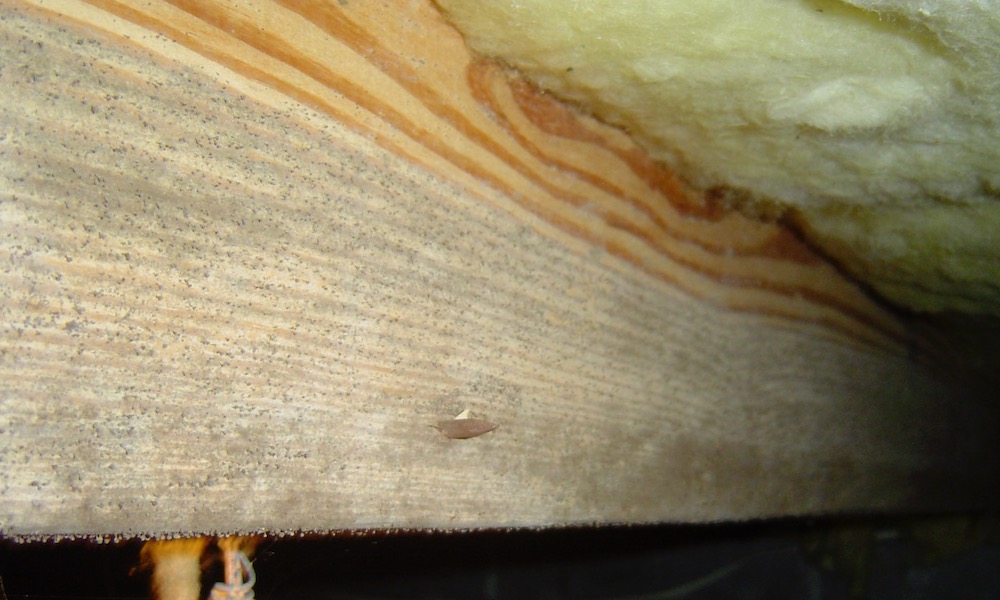
Do you have floor joists in your crawl space that look like the one to the left? In case you can’t tell how bad it really is, just click on it to see a bigger version. When you do, you’ll notice the ‘furries,’ as one of my friends called the microbial infestation growing on that wood. What’s going on here? Why is stuff growing on the wood down in the crawl space?
Well, I’m not a mold expert and haven’t identified the growth here as mold, but if it is mold, here’s what’s necessary for it to grow:
- Spores – They’re everywhere and will grow if the other conditions are met.
- Appropriate temperatures – They like pretty much the same temperatures we do, and even colder. Ever seen mold in your fridge?
- Food – Organic matter is what they like, and it’s everywhere. Mold likes cellulose (wood) and the more processed, the better. Paper is called mold candy by people who work in this field.
- Moisture – To sustain growth, a mold colony must have water. When the relative humidity of the air is 70% or higher, mold has enough water to grow.
So, of the four requirements for mold growth, the one we have most control over is moisture. Keep the materials and the air dry enough, and we won’t have a mold problem.
Have you measured the relative humidity in your crawl space? When I was doing improvements on homes, I’d install a digital thermo-hygrometer with a remote sensor in the crawl space so the homeowners could track the relative humidity. If you’re not doing this yet, and you have a crawl space, get yourself one of these devices now.
OK, so you’ve measured and determined that you do have high relative humidity in your crawl space. That’s not unusual at all, especially in a humid climate like we have here in the Southeast. Where’s the moisture coming from? And why is the humidity in a vented crawl space higher than the outdoor relative humidity? Here are three reasons.
1. Bulk Water
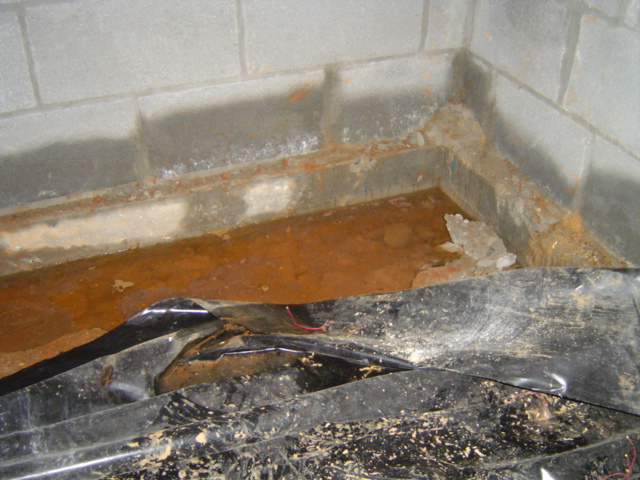
The first problem to look for is bulk water. If there’s standing water in your crawl space, you have either a drainage problem or a plumbing leak. You need to fix this immediately. Having a pond under your home is a bad, bad idea.
In the photo above, the problem was that the back yard sloped down to the house, bringing water up to the foundation wall. Since it was just a crawl space, the builder didn’t put any kind of water proofing on the concrete block or grade the yard properly to keep the hydrostatic pressure from building up against the block wall. You can see the result here. This was a new house with a serious bulk water problem. The joists were already growing stuff, and the fiberglass batt insulation was getting heavy and falling down.
2. Moisture Evaporating from the Ground
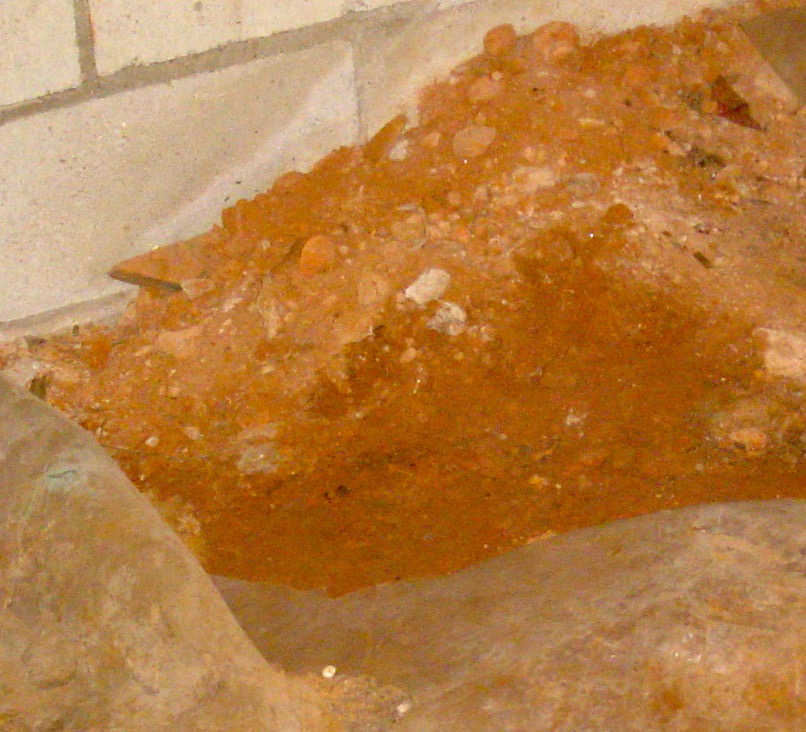
In the photo above, the ground was partially covered with a polyethylene vapor barrier. The dirt that wasn’t covered looked dry, but when I pulled the plastic back, I found that there was a lot of moisture in that soil. The soil that looked dry only looked that way because it was constantly evaporating moisture into the air of the crawl space. The foundation walls can also evaporate moisture into the air.
What do you do to solve the problem? Cover it all up with a vapor barrier!
3. Outdoor Air Coming in through the Crawl Space Vents
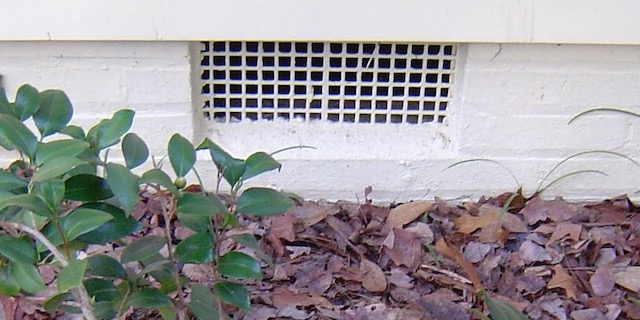
Some people find this hard to believe, but when you bring outdoor air into the crawl space, the relative humidity actually increases. Think about it this way: When air enters the crawl space, it cools down. Cool air cannot hold as much moisture as warm air, so the air that enters is now closer to its saturation point (which we call the dew point). It might’ve been 60% relative humidity outside (relative to a temperature of 90° F, say), but when that air came into the crawl space and cooled down to 75° F, the relative humidity jumped up to 95%. Not good!
The numbers here come from the psychrometric chart (invented by Willis Carrier, the inventor of the modern air conditioning system), which relates temperature and humidity of air.
What Can You Do?
If you’ve got a vented crawl space with high relative humidity caused by one or more of the above, to solve the problem, you’ve got to remove the causes. Bulk water is solved by fixing the drainage or plumbing problems. Water evaporating from the ground or coming through the vents can be fixed by encapsulating your crawl space.
One thing that does NOT work is to try to treat the symptom by installing a dehumidifier. Don’t do that!
If the problems get really bad, though, you can always keep some kayaks down there so you can get around easier.
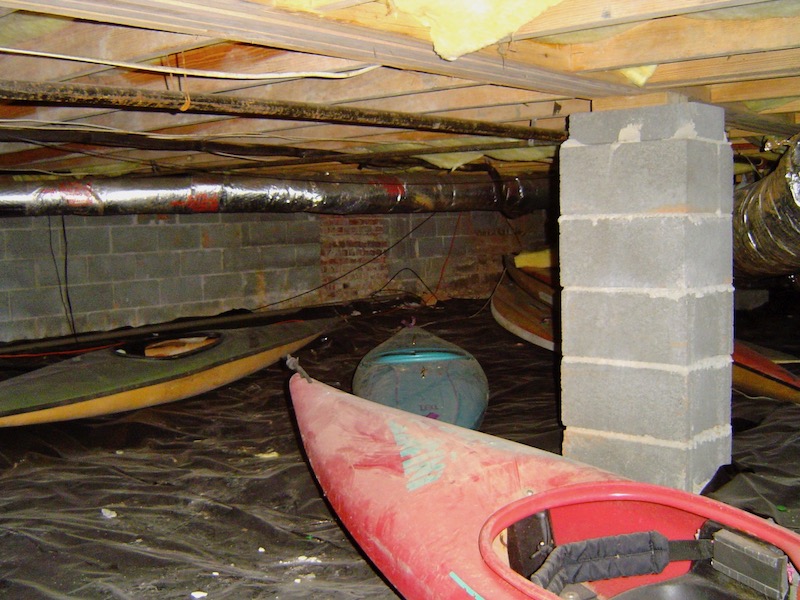
Allison Bailes of Atlanta, Georgia, is a speaker, writer, building science consultant, and founder of Energy Vanguard. He is also the author of the Energy Vanguard Blog and is writing a book. You can follow him on Twitter at @EnergyVanguard.
Related Articles
An Unexpected Benefit of Encapsulating a Crawl Space
Solving a Crawl Space Water Mystery
What Is the Best Way to Deal with Crawl Space Air?
Vented Crawl Spaces and the Psychrometric Chart Are Not Friends
NOTE: Comments are closed.
This Post Has 19 Comments
Comments are closed.

Good summary of a problem in
Good summary of a problem in the hot-humid climates. We don’t get enough of that.
If it were a basement, would you still disapprove of a dehumidifier? Is this because of it being a band-aid when the source problem still remains?
Allison. Thanks for the
Allison. Thanks for the article. I love the kayak!
For the record, mold growth starts at 60% and is sustained at 50%.
M. Johnson
M. Johnson: Thanks. I don’t disapprove of dehumidifiers for crawl spaces or basements. I actually think that they’re the best way to treat the air in those two areas in a lot of cases. My problem is with trying to use a dehumidifier without first addressing the root causes of the high humidity.
Sam: Glad you like it. I figured when I first saw those kayaks 5 years ago in that moldy crawl space, I’d find a use for a photo of them.
I knew that mold can grow at 50% RH and higher, but I’ve always heard that 70% is the threshold where it really takes off and that between 50% and 70%, it grows slowly. No? (Also, did you have your numbers reversed above?)
Allison,
Allison,
As usual, good comments, short & pithy.
I’d like to know where Sam gets his 60%-50% figures from. I’ve been doing this mold thing for 10 years and all of the xerophilic molds that I’m familiar with will only begin to grow in the 70%-74%range.
Yes, that is mold on the joist. Growth is characteristic of Cladiosporum, the most prevalent one of all.
Section R409 of the IRC speaks to Closed Crawl Spaces, worth reading.
I’ve been recommending them for 8 years. NO HOUSE SHOULD BE BUILT WITH A VENTED CRAWL SPACE. As Joe would say, its just plain stupid!
Interestingly enough the 1968 NC residential code allowed a closed, insulated crawl space, but only through a drawing in the back of the book. I can send you a copy of that drawing if you are interested.
Re dehumidifiers, they are seldom needed longterm in a properly closed crawl space – unless you like the belt and suspenders approach to things. However, they are great for initial drying of the space and it’s contained structure.
I suspect the plastic
I suspect the plastic sheeting in the kayak photo was there to give the appearance of the kayaks floating on ocean waves, rather than serve as a vapor barrier 🙂
Great article, Allison.
Great article, Allison. Vented crawls in a humid climate are an abomination! Obviously, a properly installed closed crawl is MUCH better, but the cost is high. But you still have to pay close attention to site grading and roof runoff.
I was raised in NC where there’s a definite market prejudice against slab-on-grade, where all but the least expensive homes are built on crawls. Here in the desert southwest, crawls are almost unheard of — even the most expensive homes slab-on-grade. A vented crawl would probably work fine in a hot dry climate. However, there may be other reaons why crawls are uncommon out here. In mixed climates, there’s no question that slabs are much more efficient than crawls. Basements are always the most energy efficient construction method.
Aside from first-cost, here’s the problem I have with closed crawls: The Charlotte Energy Star provider I used to work installed ‘healthy crawl spaces” in new homes. The most common configuration was R11 walls with uninsulated floor. Some homeowners complain about cold floors in rooms without carpet. Anectdotal evidence suggests that crawl temps may drop into the mid-to-high 50’s when outside are in the teens, not uncommon in that region. That’s a large delta-t across an uninsulated surface. Advanced Energy, responsible for formally developing and promoting closed crawls, did follow-on research that concluded that floor insulation (instead of walls) might be warranted in CZ4, although this puts a larger load on the ducts. In a warm climate, floor insulation will actually increase the cooling load. Interesting stuff.
BTW, the determining factor for mold growth on wood depends on the temperature and moisture content of the wood. But 70% RH is widely accepted as the threshold for mold growth in the 50 to 70 degree range. 60% is generally considered the upper end for indoor comfort. Also, dust mites thrive above 60% RH.
John R.: I
John R.: I agree that no house should be built with a vented, enclosed crawl space. (And for those who don’t know what Joe John is talking about, it’s Joe Lstiburek.) The necessity for dehumidifiers depends on how well you’re able to seal everything up (easier for new construction than existing homes) and what your strategy is for conditioning the air down there.
John P.: I don’t know if that was the real purpose, but it works well that way for my purposes.
David:
David: Lots of good info in your comment, as usual. Thanks! Regarding floor vs. wall insulation, I encapsulated the crawl space at my in-laws house here in Atlanta (Climate Zone 3) in 2008, and the temperature down there stays in the mid-60s now. There was no floor insulation before, and I insulated the walls with R-10 foamboard (2″ XPS). Of course, my father-in-law, who’s 89 now, likes to set the thermostat at 77° F, but he also walks barefoot on the floors in winter now, when he couldn’t before.
Yes, there needs to be more
Yes, there needs to be more evaluation of insulated floors vs insulated foundations in closed crawls. The very thing that is so often the cause of mold growth on joists and the bottom of insulation in vented crawls – radiational cooling – is what sometimes keeps floors a bit cool during winter.
Re the cost of closed spaces in existing homes, I’ve had a number of clients do it for less than $1.50 ft2. As the reduction in energy costs is in the 10-20% range, the payback time is quite reasonable.
I have sealed the crawlspace
I have sealed the crawlspace vents in a 90 yr old house, installed a vapor barrier, and have a dehumidifier running. The mold seems to have stopped growing, so what is the best method of mold remediation, and is there treatment I can apply to prevent future growth
Awesome explanation of these
Awesome explanation of these very common problems in Hot ‘Lanta. I would like to formally request that this article be sent to my condo association. Nice kayaks. 🙂
I just posted an updated
I just posted an updated version of my above comment in LinkedIn:
http://linkd.in/iYVAKS
I included a link to Craig DeWitt’s landmark paper from 2003 ASHRAE Journal. He was among the first to make the argument for closed crawls. His paper goes into some depth on the RH issue and wood moisture. In particular, 70% relative humidity is probably not the best reference for evaluating whether a crawl space is at risk for mold. I encourage everyone who deals with crawl spaces to read this paper.
What do you suggest for a
What do you suggest for a house in a flood zone that requires flood vents? The crawl space needs to allow the flood waters to run through, in the case of a flood. This just occurred with hurricane Sandy. We are thinking of adding a Tjernlund UnderAire Crawl Space Ventilator to help air it out.
Is a crawl space supposed to
Is a crawl space supposed to be moist at all? I don’t have standing water but it is a bit moist. I live in california
House I’m buying has wood
House I’m buying has wood moisture reading of 25.I’m a widow and no nothing about crawl spaces..I’ve been told needs new vapor barrier.Don’t want to spend thousands can’t afford it..Any suggestions. ..Is that level dangerous to my health?
Yesterday (6/27/14) we
Yesterday (6/27/14) we discovered a water leak/pin hole size appx.3′ from our water heater and appx. 6’away from the HVAC unit in the crawl space.(Typical crawl space, sloped ground from 18″ to 4′-5′ from end to end). During the repair process I noticed the insulation around the area of the leak sagging from the water weight, which is normal. However, the insulation in a very large space around the HVAC area, but not near the leak, was also saturated. As I inspected the area closer, I saw a light grayish stain on the floor joist and support beam also in these areas. I figured this was the beginning of mold or mildew forming. I was barely able to get a sample onto my fingers and inspect it.
The HVAC unit has a flex duct appx. 6′ in length connected to the forced air side of the a/c and was sagging with water. I poked 3 holes with a small blade of my knife to drain it. The orginal metal duct appx. 18′-24″ dia. was disconnected when the new HVAC unit was installed and relocated appx. 6′ away. This is where the flex duct was added.
Can improper installation of the HVAC unit cause some of the above problems ? I may need get an HVAC tech. to repair this as well. The units are only 4yrs.old.
What steps do you reccomend I take to resolve the problem(s)?
Great article and information!
Thanks for your time and attention to my interest.
@Ron, without an inspection,
@Ron, without an inspection, there’s no way to know how water got inside that duct.
Assuming it’s a supply duct, one possibility is that the outer cover for the flex was not properly sealed at each end, thus allowing humid air from the crawl to enter the space between outer and inner duct liner, bypassing the duct insulation. Any humid air that reaches the cold inner liner will naturally condense.
It’s also possible that the condensate tray is clogged and water is backing up into the duct, in which case the water would be inside the inner liner, not between the inner and outer liner.
Or a plumbing leak could make its way into the duct.
Okay, my crawlspace is sloped
Okay, my crawlspace is sloped. Why is that? Also having moisture problems – never had when I lived there..Of course I had a heat vent going to the crawlspace. I do not live there now, and have the dehumidifier going in the main house (700sf) all the time…still seems moist. Worried about keeping that building healthy!
Who is the best company to
Who is the best company to call to end the problem of mold, some termites in my crawlspace. It is an all brick home with the highest part of the crawlspace about 6 feet which then goes down to about 3 feet.